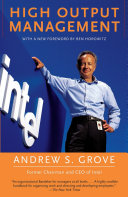

In 'High Output Management,' Andrew S. Grove emphasizes the multifaceted role of a manager. A manager is not merely a supervisor but a facilitator of productivity and effectiveness within their team. The book outlines that managers are responsible for setting the vision, aligning the team with organizational goals, and ensuring that resources are allocated efficiently. Grove introduces the concept of 'output' as a crucial metric for assessing a manager's performance. He argues that the primary output of a manager is not the work they do themselves but the work they enable their team to accomplish. This perspective shifts the focus from individual contributions to collective outcomes, highlighting the importance of delegation, motivation, and team dynamics. Managers must cultivate an environment where employees feel empowered to take initiative and contribute to the organization's goals. Grove also discusses the importance of communication, emphasizing that effective managers must be adept at conveying information, providing feedback, and fostering open dialogue within their teams. This multifaceted role requires a blend of technical skills, interpersonal skills, and strategic thinking.
Continue readingGrove emphasizes the significance of measuring output as a means to assess performance and productivity. He introduces various metrics that managers can use to evaluate both individual and team performance. The focus is on creating measurable outcomes that align with the organization's objectives. Grove discusses the importance of setting clear goals and key performance indicators (KPIs) that provide a framework for assessing progress. He also highlights the need for regular performance reviews and feedback loops to ensure that teams remain aligned with their goals. This approach to output measurement fosters accountability and encourages continuous improvement. By quantifying output, managers can identify areas for enhancement, recognize high performers, and make data-driven decisions that contribute to the overall success of the organization. Grove's insights into output measurement serve as a valuable framework for managers seeking to optimize their team's performance.
Continue readingGrove dedicates a significant portion of 'High Output Management' to discussing the role and structure of meetings in an organization. He posits that meetings, when effectively managed, can be a powerful tool for communication, decision-making, and collaboration. However, he also warns against poorly structured or unnecessary meetings that waste time and resources. Grove outlines the characteristics of effective meetings, including clear agendas, defined objectives, and participant engagement. He introduces the concept of 'one-on-ones' as a critical component of managerial communication, allowing for personalized feedback and relationship-building. Additionally, he discusses the importance of follow-up actions and accountability in ensuring that meetings lead to tangible outcomes. By emphasizing the strategic use of meetings, Grove provides managers with practical tools to enhance collaboration and drive results within their teams.
Continue readingIn the book, Grove explores various decision-making frameworks that managers can utilize to navigate complex situations. He emphasizes the need for a structured approach to decision-making, particularly in high-stakes environments. Grove introduces the concept of 'decision trees' as a visual tool to map out potential outcomes and consequences of different choices. He also discusses the importance of involving team members in the decision-making process to foster buy-in and leverage diverse perspectives. Grove's insights into decision-making highlight the need for managers to balance analytical thinking with intuition, ensuring that decisions are informed yet adaptable to changing circumstances. By equipping managers with effective decision-making frameworks, Grove empowers them to make sound choices that drive organizational success.
Continue readingGrove places a strong emphasis on the importance of time management for managers. He argues that effective time management is critical for maximizing productivity and ensuring that managers can focus on high-impact activities. The book presents various strategies for prioritizing tasks, delegating responsibilities, and managing distractions. Grove introduces the concept of 'time boxing,' where managers allocate specific time slots for tasks to enhance focus and efficiency. He also discusses the significance of understanding the difference between urgent and important tasks, encouraging managers to prioritize long-term goals over short-term pressures. By mastering time management, managers can optimize their productivity and lead their teams more effectively.
Continue readingFeedback is a central theme in 'High Output Management,' with Grove emphasizing its role in fostering a culture of continuous improvement. He advocates for regular performance reviews as a means to provide constructive feedback, recognize achievements, and identify areas for growth. Grove highlights the importance of creating a safe environment for feedback, where employees feel comfortable discussing challenges and seeking guidance. He introduces the concept of '360-degree feedback,' where input is gathered from multiple sources to provide a comprehensive view of an employee's performance. By establishing a feedback-rich culture, managers can drive engagement, enhance performance, and support the professional development of their team members.
Continue readingGrove emphasizes the importance of cultivating a positive team culture as a foundation for organizational success. He discusses the role of values, norms, and behaviors in shaping team dynamics and influencing performance. Grove advocates for fostering a culture of trust, collaboration, and accountability, where team members feel valued and motivated to contribute. He highlights the significance of aligning team culture with organizational goals, ensuring that employees understand how their contributions impact the larger mission. Additionally, Grove discusses strategies for addressing conflicts and promoting open communication within teams. By prioritizing team culture, managers can create an environment that supports innovation, engagement, and sustained high performance.
Continue reading